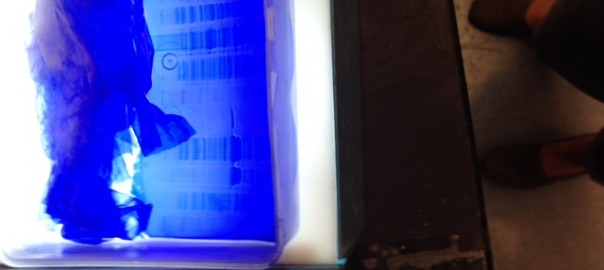I loved the week at NCCAT. It’s hard to pick a particular highlight. I loved getting to know the other fellows, I picked up some resources that will be AWESOME in my classroom, and I got to get back to nature a bit with the beautiful trails and fantastic rafting trip. I think my greatest take-away, however, is a sense of renewed excitement for teaching. As much as I am loving my summer externship, I miss my students and being a teacher. I can’t wait to get back into my classroom. But, in the mean time, I’ve been having a great time learning how to science (as an English teacher, I can verb words as I please).
I spent most of my first week in the lab following behind postdocs and undergrads lost-puppy style, getting turned around (all 500 liter tanks of Co2 start to look the same after a while), and just generally looking confused and pathetic. This week I decided to just jump in and give it a try myself. As with most things in life, confidence, an adventurous attitude, and a little self-deprecating humor went a long way.
I’ve enjoyed a bit of beginners luck. Over the course of the week I ran protein purifications for 4 different proteins, all of which have been successful. Purifying protein is like making really finicky, annoying desserts like soufflés or macrons. It takes 6-8 hours, and the smallest errors in measurement, temperature, and timing can equal disaster (I guess with soufflés or macrons you just don’t get dessert…with purifying protein you’ve lost a week’s worth of work and run through some expensive materials in the process).
The proteins that Brian Strahl and his team are studying are located in the cell nucleus, bound to strands of DNA and other proteins. Getting just the proteins by themselves so they can be studied in interaction with other proteins and enzymes isn’t easy. After cultivating the bacteria (while forcing them to retain the desired peptides), you then have to destroy the cells. Destroying the cells is my favorite part (mwah-ha-ha-ha). You can either use a sonicator, which blasts through the cells with high-pitched sound frequencies, or you can use the “French Press.” The French Press isn’t the lab coffee maker; it’s a high-powered hydraulic pump that puts the cells under extreme pressure, causing them to implode and break apart.
After breaking apart the cells, you have to run a series of reactions to isolate the protein. After each of these reactions, the solutions have to spend time in the centrifuge to separate the good stuff from the waste. It seems like centrifuge time makes up the majority of those 6-8 hours. Fortunately there is plenty to do while you’re waiting. There are gels to prep and buffers to mix. The purpose of the gel is simply to verify that the protein you want is in the final “elution.” Science can be rough: after the days of preparation and those 6-8 hours of protocol, sometimes the protein is in the elution, and sometimes it isn’t. And, often, a lack of protein in the elution isn’t the result of a “mistake” on the researcher’s part. That particular protein just needs a tweak in the protocol (and good luck figuring out what that is).
Considering I only kind of know what I’m doing, successfully eluting 4 proteins in a week makes me feel really lucky. I may plan a trip to Vegas. Here is one of my gels from the week:
The blue bands showing up on the gel indicate protein present in the solution. I loaded different steps from the protocol in each lane, starting with pre-induction, soluble, insoluble, and elution (the very first lane contains a ‘ladder’ which helps you estimate the presence of a particular protein…more on that soon). In the first three lanes, there are multiple proteins present because the protein of interest hasn’t been purified in those steps. In the last lane, however, there is just one band showing up…the TAF14 protein I was trying to isolate! I can be confident that that is the TAF14 protein and not something else because it falls on the correct location on the gel. The gel is designed to allow molecules to pass through with an electric current. The smaller the molecule, the farther it travels. The ladder places colored lines at various points along the gel, indicating the approximate size of the molecules at that location. By estimating the size of a molecule in kilodaltons, you know where it should appear on the gel.
All this, believe it or not, is just the first step in the process of studying how these proteins interact. To extend my dessert metaphor, I haven’t actually made the soufflé yet, I’ve just collected all the ingredients. Next week I’ll be doing peptide pulldown protocols where I’ll get to see whether or not the proteins I isolated bond as we expect them to…

